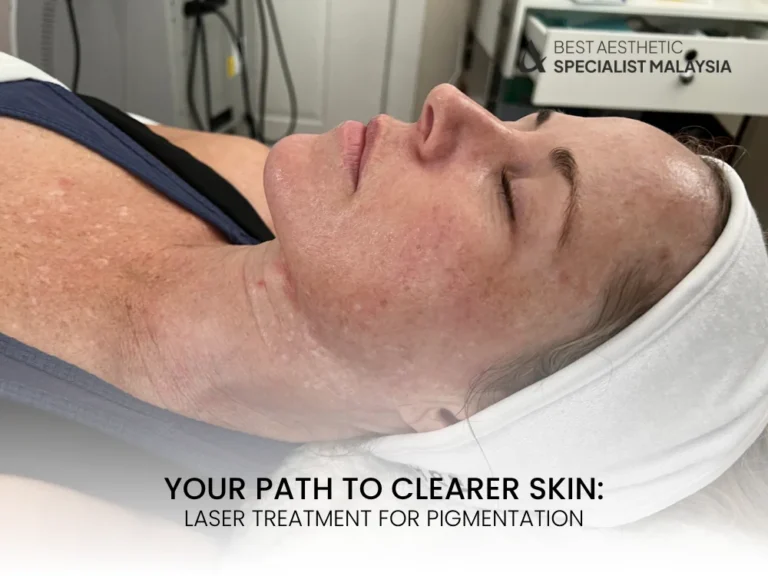Uneven skin tone, dark spots, and sun-damaged patches can affect your confidence and make you feel like you’re constantly covering up. Fortunately, advancements in cosmetic dermatology have introduced effective ways to treat stubborn pigmentation issues—one of the most sought-after being laser treatment for pigmentation.
Let’s explore how this treatment works, what types of pigmentation it targets, the technology behind it, and what you can expect in terms of results and recovery.
Understanding Pigmentation and Its Causes
Skin pigmentation occurs when melanin—your body’s natural pigment—forms unevenly. This can result in patches or spots that are darker than your normal skin tone. Common types of pigmentation include:
- Melasma – hormone-related pigmentation, often seen during pregnancy
- Sunspots (Solar Lentigines) – caused by prolonged UV exposure
- Post-inflammatory hyperpigmentation – from acne, burns, or injuries
- Freckles – genetic but can darken with sun exposure
Environmental stress, hormonal changes, and even medications can all contribute to pigmentation. And once it develops, it can be stubborn to treat using just creams or serums.
What Is Laser Treatment for Pigmentation?
Laser treatment for pigmentation uses focused light energy to break down pigmented skin cells. The pigment absorbs the light, heats up, and eventually breaks into smaller particles, which the body naturally clears away through its lymphatic system.
There are several types of laser treatment for pigmentation used:
- Q-Switched Nd:YAG Laser – ideal for deep pigmentation and melasma
- Fractional CO2 Laser – treats sunspots and textural issues
- PicoSure and PicoWay – deliver ultra-short pulses for minimal downtime
Each laser treatment for pigmentation is suited to different depths and skin types. A skilled dermatologist will select the most appropriate option for your unique skin condition.

Benefits of Laser Pigmentation Removal
Why are more and more people choosing laser pigmentation removal over traditional methods like topical creams, chemical peels, or microdermabrasion? The answer lies in the unmatched precision, efficiency, and transformative results that laser technology offers.
Precision Targeting of Pigmented Areas
One of the most compelling benefits of laser treatment for pigmentation is its ability to precisely target pigmented lesions without affecting the surrounding healthy skin. Unlike creams or peels that work on the entire skin surface, laser devices are calibrated to detect and treat only the melanin-rich areas. This results in a more even skin tone with significantly reduced risk of irritation, scarring, or post-inflammatory hyperpigmentation. This is especially important for people with darker skin tones, where maintaining pigment balance is crucial.
Quick and Convenient Sessions
Time is a major factor in treatment decisions—and laser pigmentation removal shines in this area. Most sessions are quick, typically lasting only 15 to 30 minutes depending on the size and number of spots being treated. This makes it an ideal “lunchtime procedure” for busy individuals who want fast results without sacrificing their daily schedule. With no extensive preparation or prolonged recovery time, patients can return to work or social activities immediately after the session.
Minimal Downtime and Discomfort
Another reason why lasers are gaining popularity is the reduced downtime compared to other treatments. Thanks to advancements in technology, modern lasers are much gentler on the skin. You may experience slight redness or warmth for a few hours post-treatment, but these side effects are generally mild and temporary. There’s no need to hide indoors for days or worry about excessive peeling or inflammation, which is common with deeper chemical peels.
Long-Lasting and Visible Results
Perhaps the biggest advantage is the long-term effectiveness of laser treatment for pigmentation. While topical treatments often provide temporary improvements or require ongoing use, laser procedures offer more permanent results by breaking down the pigment at a deeper dermal level. With proper skincare maintenance and diligent sun protection, patients can enjoy clearer, more radiant skin for months or even years. The recurrence of pigmentation is significantly reduced, especially when combined with a well-planned skincare routine tailored to your skin type and condition.
Who Is a Good Candidate for Laser Treatment for Pigmentation?
Most people with persistent pigmentation, especially those who’ve tried topical treatments without success, are potential candidates. However, skin type matters. Individuals with darker skin tones need careful evaluation, as certain lasers may increase the risk of post-treatment pigmentation changes.
Always consult with a certified dermatologist to determine if your pigmentation is suitable for laser therapy and which laser technology is best for your skin tone and type.
How Many Sessions Will You Need?
Pigmentation doesn’t vanish overnight. It often takes multiple sessions—typically 3 to 6 spaced 4–6 weeks apart—to see noticeable improvement. However, some people see significant fading even after the first treatment.
The number of sessions depends on:
- Type and depth of pigmentation
- Laser type used
- Your skin’s healing response
What to Expect During the Procedure
Laser treatment for pigmentation is usually performed in a clinic and doesn’t require anesthesia, though a numbing cream might be applied for comfort.
- The skin is cleansed thoroughly.
- Protective goggles are worn to shield the eyes.
- The laser is then passed over pigmented areas, delivering quick pulses of light.
- You may feel a slight snapping or warm sensation, like a rubber band on the skin.
After treatment, you might experience redness, mild swelling, or flaking for a few days—akin to a mild sunburn. It’s crucial to avoid direct sunlight and follow post-care instructions strictly.
Results: How Soon Will You See Clearer Skin?
Improvements are usually visible within 1 to 2 weeks after your first session. Pigmentation will gradually fade as the body clears the shattered pigment particles. For deep or extensive pigmentation, full results may take a few months.
Consistency is key. Skipping sessions or neglecting sun protection can slow or reverse progress.

Post-Treatment Skincare Tips
To maintain your results and protect your skin:
- Use broad-spectrum sunscreen daily (SPF 50+)
- Avoid sun exposure, tanning beds, and heat treatments for at least 2 weeks
- Stick to gentle, non-irritating skincare products
- Avoid picking or scrubbing peeling skin
Adding ingredients like Vitamin C, niacinamide, and hyaluronic acid to your skincare routine can support healing and boost radiance.
Potential Side Effects and Risks
Though generally safe, laser pigmentation treatments can have minor side effects, including:
- Temporary redness or swelling
- Skin flaking or peeling
- Hyperpigmentation or hypopigmentation (especially in darker skin tones)
- Rare risk of scarring
Choosing a qualified, experienced provider reduces the risk of complications and ensures tailored treatment for your skin type.
How Does It Compare to Other Treatments?
Treatment Type | Best For | Downtime | Effectiveness |
Laser Treatment | Deep pigmentation, melasma | Low | High (multiple sessions) |
Chemical Peels | Surface discoloration | Medium | Moderate |
Topical Creams | Mild pigmentation | None | Slow, requires consistency |
Microdermabrasion | Texture + minor pigmentation | Minimal | Mild |
Lasers often outperform others in targeting stubborn and deep pigmentation.
FAQs
1. How long do results from laser pigmentation treatment last?
Results can last for several months to years with proper sun protection and skincare. However, new pigmentation can develop due to sun exposure or hormonal changes.
2. Is laser treatment for pigmentation painful?
Most patients describe it as a mild snapping sensation. Numbing creams can reduce discomfort, and newer laser technologies are gentler on the skin.
3. Can all skin types benefit from laser treatment for pigmentation?
Yes, but darker skin tones require specific laser types and settings to avoid complications. Always consult with an experienced dermatologist.
4. How soon can I wear makeup after treatment?
Generally, you can resume wearing makeup 24–48 hours post-treatment, once any redness or peeling has subsided.
5. Are results permanent?
While treated pigmentation may not return, new spots can develop over time. Regular skincare and sun avoidance are essential to maintain results.
6. What are the side effects of laser pigmentation treatment?
Common side effects include temporary redness, swelling, and mild peeling. These usually subside within a few days. Rarely, blistering or temporary hyperpigmentation may occur, especially if post-care instructions aren’t followed properly.
7. How many sessions are needed for optimal results?
Most individuals require between 2 to 6 sessions spaced 4 to 6 weeks apart, depending on the severity of the pigmentation and skin type. Your dermatologist will customize the treatment plan for your specific needs.
8. Can laser pigmentation treatment be combined with other skin treatments?
Yes, treatments like chemical peels, microneedling, and topical creams are often combined to enhance results. However, combinations should be professionally planned to avoid over-irritation.
9. What should I avoid after laser pigmentation treatment?
Avoid direct sun exposure, tanning beds, hot showers, saunas, and active skincare ingredients (like retinol or acids) for at least a few days. Always apply sunscreen diligently.
10. Is there any downtime after the treatment?
Downtime is minimal. Most people experience mild redness or peeling that resolves within 2 to 5 days. You can usually return to daily activities almost immediately.
11. Does insurance cover laser pigmentation removal?
Typically, laser pigmentation treatments are considered cosmetic and are not covered by insurance. However, it’s always best to check with your provider and insurance policy.
Final Thoughts
Laser treatment for pigmentation offers an effective and often transformative solution for uneven skin tone. With precision targeting, minimal downtime, and long-lasting effects, it has become a top choice for individuals seeking radiant, even-toned skin. However, it’s vital to consult a skilled provider, follow through with sessions, and maintain consistent sun protection for best results.

